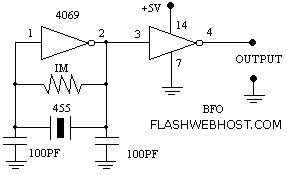
 |
| FlashWebHost.com | Resources | Ham Radio Circuits | Ham Radio | SSB Transceiver | |
Most experienced amateurs know that SSB (single side band) reception requires a receiver fitted with a product detector or BFO (beat frequency oscillator) to reinsert the missing carrier. They also know that such receivers command significantly higher prices than AM only models.
It is also a fact that signals broadcast using SSB tend to be far more interesting to amateurs and shortwave listeners than the standard AM broadcasts. The problem is most readers only have a standard AM shortwave receiver - onet that is incapable of SSB reception.
This simple circuit serves that problem. It uses only a handful of parts, will cost you less than $5 to build and will convert your AM shortwave receiver to SSB reception.

To understand how the adaptor works, it is necessary to explain the basic differences between AM and SSB transmissions.
A modulated AM signal consists of a carrier and two symmetrically spaced side bands. The amplitude of the carrier is a function of the amplitude of the modulating signal.
The two side bands on either side of the carrier have the same amplitude and carry the same information. This is why AM is also sometimes reffered to as double side band, or DSB in short. In fact the carrier itself conveys no information. In mathematical terms : AM power = carrier power + side band power
By removing one side band and the carrier, more efficient use of the available transmitter power is made without sacrificing the transfer of information from transmitter to receiver. In fact, an SSB transmitter uses approximately one quarter the power of an equivalent AM transmitter.
Another advantage of SSB operation is that the band width required to transmit the signal is significantly reduced. So by removing the carrier and one sideband, we can make more efficient use of the RF spectrum.
To demodulate an SSB signal (ie, to turn it back into intelligible speech), it is necessary to insert a locally generated carrier at the receiver. This carrier can be generated by using an external oscillator tuned to the receiver's intermediate frequency (IF) - in this case. 455 KHz. The new carrier provides a reference frequency against which the upper or lower side band can be demodulated.
Note that the opposite side band is also generated during this process, so that a complete AM signal is available for detection.
OK, so that's how we convert an inexpensive short wave receiver to SSB operation. It's an arrangement that can be made to work quite well but don't expect it to perform as well as a fully-fledged SSB receiver with narrow band IF stages and special audio filters.
The heart of the circuit is a 455 KHz ceramic resonator. This provides a reliable 455 KHz source at a fraction of the cost of a crystal. The resonator is used in the CMOS oscillator circuit and provides an RF output level of 5 volt peak to peak.
The output of the oscillator is then fed to a length of insulated hookup wire which is wrapped several times around the receiver, thus providing a degree of inductive coupling. The amount of signal required varies from receiver to receiver and can be adjusted by varying the number of turns.
The unit can be easily be made up on a small piece of Vero board. Note that all the unused input and output pins on the 4069 are grounded to prevent spurious oscillation.
Because the ceramic resonator operates at fixed frequency, no tuning of the circuit is required. To demodulate an SSB signal, first tune your AM radio to and SSB signal. You can then wrap the oscillator output lead around the receiver, apply 5 volt, and carefully tune your receiver for best quality demodulated audio.
By Garry Cratt, VK2YBX
| Website designed by FlashWebHost.com. All rights reserved. |